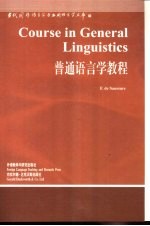

普通语言学教程 英文版PDF电子书下载
- 电子书积分:10 积分如何计算积分?
- 作 者:(瑞士)费尔迪南·德·索绪尔(F.de Saussure)著;(英)Poy Harris译;张绍杰导读
- 出 版 社:北京:外语教学与研究出版社
- 出版年份:2001
- ISBN:7560023746
- 页数:245 页
INTRODUCTION 1
CHAPTER I. A brief survey of the history of linguistics. 1
CHAPTER II. Data and aims of linguistics: connexions with related sciences. 6
CHAPTER III. The object of study. 8
1.On defining a ianguage 8
Preface by Halliday 11
2.Linguistic structure: its place among the facts of language 11
王宗炎序 12
3.Languages and their place in human affairs Semiology 15
Preface by Chomsky 15
CHAPTER IV. Linguistics of language structure and linguistics of speech 18
CHAPTER V. Internal and external elements of a language 21
沈家煊序 22
1.Why it is necessary to study this topic 24
CHAPTER VI. Representation of a language by writing. 24
2.The prestige of writing :reasons for its ascendancy over the spoken word 24
导读 25
3.Systems of writing 26
4.Causes of inconsistency between spelling and pronunciation 27
5.Consequences of this inconsistency 29
CHAPTER VII. Physiological phonetics. 32
1.Definition of the subject 32
2.Transcription 33
3.Writingasas evidence 34
APPENDIX PRINCIPPES OF PHYSIOLOGICAL PHONETICS 39
CHAPTER I. Sound types. 39
1.On defining speech sounds 39
2.The vocal apparatus and how it works 41
Translator s Introduction 41
3.Classification of sounds by oral articulation 44
Preface to the First Edition 49
1.Necessity of studying sounds in spoken sequences 50
CHAPTER II. Sounds in spoken sequences. 50
2.Adduction and abduction 52
Preface to the Third Edition 52
Preface to the Second Edition 52
3.Combinations of adduction and abduction in the spoken sequence 54
4.Syllabic boundaries and vocalic peaks 57
5.Criticism of theories of syllabification 58
6.Duration of adduction and abduction 59
7.Sounds of aperture 4 Diphthongs Questions of spelling Editorial note 62
1.Sign,signification,signal 65
CHAPTER I. Nature of the linguistic sign. 65
PART ONE GENERAL PRINCIPLES 65
2.First principle: the sign is arbitrary 67
3.Second principle: linear character of the signal 69
CHAPTER II. Invariability and variability of the sign. 71
1.Invariability 71
2.Variability 74
CHAPTER III. Static linguistics and evolutionary linguistics. 79
1.Internal duality of all sciences concerned with values 79
2.Internal duality and the history of linguistics 81
3.Examples of internal duality 83
4.Difference between the two orders illustrated by comparisons 87
5.Synchronic and diachronic linguistics. Their methods and principles contrasted 89
6.Synchronic laws and diachronic laws 90
7.Is there a panchronic point of view? 94
8.Consequences of the confusion of synchrony with diachrony 94
9.Conclusions 96
PART TWO SYNCHRONIC LINGUISTICS 99
CHAPTER I. General observations. 99
1.Entities and units Definitions 101
CHAPTER II. Concrete entities of a language. 101
2.Methods of delimitation 102
3.Practical difficulties of delimitation 103
4.Conclusion 105
CHAPTER III. Identities, realities, oalues. 106
CHAPTER IV. Linguistic value. 110
1.The language as thought organised in sound 110
2.Linguistic value: conceptual aspects 112
3. Linguistic value: material aspects 116
4.The sign as a whole 118
1.Definitions 121
CHAPTER V. Syntagmatic relations and associative relations. 121
2.Syntagmatic relations 122
3.Associative relations 123
1.Syntagmatic interdependences 126
2.Simultaneous functioning of both types of group 127
1.Their nature and purpose 127
3.Absolute arbitrariness and relative arbitrariness 130
CHAPTER VIIl. Grammar and its subdivisions. 133
1.Definitions. Traditional divisions 133
2.Rational divisions 135
CHAPTER VIII. Abstract entities in grammar 136
CHAPTER VI. The language mechanism. 136
PART THREE DIACHRONIC LINGUISTICS 139
CHAPTER I. General observations. 139
CHAPTER II. Sound changes 143
1.Their absolute regularity 143
2.Conditioning of sound changes 143
3.Methodological considerations 145
4.Causes of sound change 145
5.The scope of sound change is unpredictable 150
1.Breaking grammatical links 152
CHAPTER III. Grammatical consequences of phonetic evolution. 152
2.Obliteration of word-composition 153
3.There are no phonetic doublets 154
4.Alternation 155
5.Laws of alternation 157
6.Alternation and grammatical link 159
1.Definition and examples 160
CHAPTER IV.Analogy. 160
2.Analogies are not changes 162
3.Analogy as the creative principle in languages 164
CHAPTER V. Analogy and evolution 167
1.How an analogical innovation enters the language 167
2.Analogical innovations as symptoms of changes in interpretation 168
3.Analogy as a principle of renovation and conservation 170
CHAPTER VI. Popular etymology. 172
CHAPTER VII. Agglutination. 175
1.Definition 175
2.Agglutination and analogy 176
CHAPTER VIII. Diachronic units, identities and realities. 178
APPENDICES 182
A. Subjective and objective analysis 182
B. Subjective analysis and determination of units smaller than the word 183
C. Etymology 187
PART FOUR GEOGRAPHICAL LINGUISTICS 189
CHAPTER I. On the diversity of languages, 189
CHAPTER II. Geographical diversity: its complexity. 192
1.Coexistence of several languages in the same place 192
2.Literary language and local dialect 193
CHAPTER III. Causes of geographical diversity. 196
1.Time, the essential cause 196
2.Linguistic areas affected by time 198
3.Dialects have no natural boundaries 200
4.Languages have no natural boundaries 202
CHAPTER IV. Propagation of linguistic waves. 204
1.Force of intercourse and parochialism 204
2.A single principle underlying both forces 206
3.Linguistic differentiation in separate areas 206
PART FIVE QUESTIONS OF RETROSPEOTIVE LINGUISTICS CONCLUSION 211
CHAPTER I. The two perspectives of diachronic linguistics. 211
CHAPTER II. Earliest languages and prototypes. 214
CHAPTER III. Reconstructions. 217
2.Degree of certainty of reconstructions 219
CHAPTER IV. Linguistic evidence in anthropology and prehistory 221
1.Languages and races 221
2.Ethnicity 222
3.Linguistic paleontology 223
4.Linguistic types and group mentality 225
CHAPTER V. Language families and linguistic types 227
Index 231
文件索引 237
- 《名医教你练走颈肩腰腿痛》许学猛 2018
- 《卓有成效的管理者 中英文双语版》(美)彼得·德鲁克许是祥译;那国毅审校 2019
- 《程序逻辑及C语言编程》卢卫中,杨丽芳主编 2019
- 《幼儿园课程资源丛书 幼儿园语言教育资源》周兢编 2015
- 《AutoCAD 2018自学视频教程 标准版 中文版》CAD/CAM/CAE技术联盟 2019
- 《博士教你识中药》(中国)黄汉超 2019
- 《跟孩子一起看图学英文》张紫颖著 2019
- 《高等学校“十三五”规划教材 C语言程序设计》翟玉峰责任编辑;(中国)李聪,曾志华,江伟 2019
- 《保教知识与能力》师大教科文教材编写组编著 2020
- 《AutoCAD机械设计实例精解 2019中文版》北京兆迪科技有限公司编著 2019
- 《书情书》(德)布克哈德·施皮南(Burkhard Spinnen)著;(德)琳娜·霍文 2019
- 《美国的伤痕 独立战争与美国政治的暴力基因》(德)霍尔格·霍克(Holger Hoock)著 2019
- 《文明的衰落与复兴》张娜责编;陈维政总主编;孙林译者;(德)阿尔伯特·史怀哲 2019
- 《厄特克尔家族》(德)鲁迪格·杨布鲁特著 2018
- 《弗里德里希·李斯特传》朱希滨责编;贾根良,梅俊杰总主编;梅俊杰译者;(德)欧根·文得乐 2019
- 《弗利克家族》(德)托马斯·拉姆什著 2018
- 《剑桥国际英语写作教程 从句子到段落》(美)劳里·布拉斯(Laurie Blass),(美)德德拉·戈登(Deborah Gordon)编著 2019
- 《量子系统的非平衡多体理论》(意)G.斯蒂芬尼茨,(德)R.冯·莱文 2019
- 《微观经济学》(美)罗伯特·S. 平狄克,(美)丹尼尔·L.鲁宾费尔德著 2019
- 《吃 食物如何改变我们人类和全球历史》菲利普费尔南多阿梅斯托 2020
